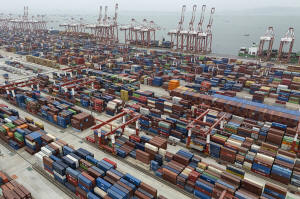U.S. economy shrinks 0.3% in first quarter as Trump trade wars disrupt
businesses
[May 01, 2025] By
PAUL WISEMAN and CHRISTOPHER RUGABER
The U.S. economy shrank at a 0.3% annual pace from January through
March, the first drop in three years, as President Donald Trump's trade
wars disrupted business. First-quarter growth was slowed by a surge in
imports as companies in the United States tried to bring in foreign
goods before Trump imposed massive tariffs.
The January-March drop in gross domestic product — the nation's output
of goods and services — reversed a 2.4% gain in the last three months of
2024. Imports grew at a 41% pace, fastest since 2020, and shaved 5
percentage points off first-quarter growth. Consumer spending also
slowed sharply — to 1.8% growth from 4% in October-December last year.
Federal government spending plunged 5.1% in the first quarter.
Forecasters surveyed by the data firm FactSet had, on average, expected
the economy to eke out 0.8% growth in the first quarter, but many
expected GDP to fall.
Financial markets sank on the report. The Dow Jones tumbled 400 points
at the opening bell shortly after the GDP numbers were released. The S&P
500 dropped 1.5% and the Nasdaq composite fell 2%.
The surge in imports — fastest since 1972 outside COVID-19 economic
disruptions — is likely to reverse in the second quarter, removing a
weight on GDP. For that reason, Paul Ashworth of Capital Economics
forecasts that April-June growth will rebound to a 2% gain.

Trade deficits reduce GDP. But that’s mainly a matter of mathematics.
GDP is supposed to count only what’s produced domestically. So imports —
which the government counts as consumer spending in the GDP report when
you buy, say, Swiss chocolates — have to be subtracted out to keep them
from artificially inflating domestic production.
And other aspects of Wednesday's GDP report suggested that the economy
looked solid at the start of the year.
A category within the GDP data that measures the economy’s underlying
strength rose at a healthy 3% annual rate from January through March, up
from 2.9% in the fourth quarter of 2024. This category includes consumer
spending and private investment but excludes volatile items like
exports, inventories and government spending.

Still, many economists say that Trump's massive import taxes — the
erratic way he's rolled them out — will hurt growth in the second half
of the year and that recession risks are rising.
“We think the downturn of the economy will get worse in the second half
of this year,'' wrote Carl Weinberg, chief economist at High Frequency
Economics. "Corrosive uncertainty and higher taxes — tariffs are a tax
on imports — will drag GDP growth back into the red by the end of this
year.''
[to top of second column] |

Shipping containers are seen ready for transport at the Guangzhou
Port in the Nansha district in southern China's Guangdong province,
April 17, 2025. (AP Photo/Ng Han Guan, File)
 Wednesday’s report also showed an
increase in prices that is likely to worry the Federal Reserve which
is still trying to cool inflation after a severe pandemic run-up.
The Fed’s favored inflation gauge – the personal consumption
expenditures, or PCE, price index – rose at an annual rate of 3.6%,
up from 2.4% in the fourth quarter. Excluding volatile food and
energy prices, so-called core PC inflation registered 3.5%, compared
with 2.6% from October-December. The central bank wants to see
inflation at 2%.
The first-quarter GDP numbers “highlight the bind that the Federal
Reserve is in,” Ryan Sweet of Oxford Economics wrote in a
commentary. The Fed must weigh whether to cut interest rates to
support economic growth or leave rates high because of elevated
inflation. “The economy was essentially stagnant in the first three
months of the year while growth in headline and core inflation
accelerated, fanning concerns of stagflation.’’
Trump inherited a solid economy that had grown steadily despite high
interest rates imposed by the Fed in 2022 and 2023 to fight
inflation. His erratic trade policies — including 145% tariffs on
China — have paralyzed businesses and threatened to raise prices and
hurt consumers.
Democrats were quick to blame Trump for disrupting several years of
solid economic growth. Democratic Sen. Elizabeth Warren of
Massachusetts said: “100 days into his presidency, Donald Trump’s
red-light, green-light tariffs are shrinking our economy, with
businesses stockpiling imports in anticipation of tariff doomsday.″
There is potential evidence emerging that the solid job market, a
pillar of the U.S. economy during the pandemic recession, may be
weakening.
On Wednesday, payroll provider ADP reported that companies added
just 62,000 jobs in April, about half of what was expected, and down
from 147,000 in March. That could be a signal that businesses may be
taking a more cautious approach to hiring amid uncertainty over
tariffs. Still, the ADP figures often diverge from the government’s
jobs reports, which arrive Friday.
Employers in the education and health, information technology, and
business and professional services industries all cut jobs. Business
and professional services include sectors such as engineering,
accounting and advertising.
“Unease is the word of the day,” said Nela Richardson, chief
economist at ADP. “It can be difficult to make hiring decisions in
such an environment.”
All contents © copyright 2025 Associated Press. All rights reserved |